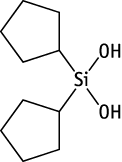

The single oral dose LD50 value of dicyclopentylsilanediol was found to be above 2000 mg/kg for both sexes.
Dicyclopentylsilanediol was studied for oral toxicity in rats in a 90-day repeat dose toxicity test at 0, 40, 200 and 1000 mg/kg. Ataxic gait and salivation were observed in the 200 and 1000 mg/kg groups, and decrease in locomotor activity was observed in the 1000 mg/kg group. Body weight was decreased in the 1000 mg/kg group. Blood chemical examination revealed an increase in total cholesterol in the 200 and 1000 mg/kg groups and a decrease in triglyceride in the 1000 mg/kg group. Liver weight was increased in the 200 and 1000 mg/kg groups, and enlargement and dark brownish color of the liver were observed in the 1000 mg/kg group. Hypertrophy of hepatocytes was observed in the 200 and 1000 mg/kg groups. In the thyroid, hypertrophy of the follicular cell was observed in the 1000 mg/kg group. In the kidneys, increase in the appearance of hyaline droplets in the proximal tubular epithelium was observed in males of the 1000 mg/kg group. These changes disappeared or diminished after withdrawal.
The NOEL is considered to be 40 mg/kg/day for both sexes.
A reverse mutation test of dicyclopentylsilanediol in bacteria was carried out. This substance was not mutagenic in Salmonella typhimurium TA100, TA1535, TA98, TA1537 and Escherichia coli WP2 uvrA, with or without an exogenous metabolic activation system.
Genotoxicity of dicyclopentylsilanediol was studied by chromosomal aberration test using cultured Chinese hamster lung (CHL/IU) cells. Dicyclopentylsilanediol did not induce structural chromosomal aberrations or polyploidy at any dose, with and without metabolic activation.
| Purity | : | >99 % |
| Test species/strains | : | Rat/Crj:CD(SD)IGS |
| Test method | : | OECD Test Guideline 401 |
| Route | : | Oral (gavage) |
| Dosage | : | 0(vehicle), 500, 1000, 2000 mg/kg |
| Number of animals/group | : | Males, 5; females, 5 |
| Vehicle | : | 0.5 % CMC-Na aqueous solution mixed with 0.1 % Tween 80 |
| GLP | : | Yes |
Test results:
| Purity | : | >99 % |
| Test species/strain | : | Rat/Crj:CD(SD)IGS |
| Test method | : | OECD Test Guideline 408 |
| Route | : | Oral (gavage) |
| Dosage | : | 0(vehicle), 40, 200, 1000 mg/kg/day |
| Number of animals/group | : | Males, 10; females, 10 |
| Vehicle | : | 0.5 % CMC-Na aqueous solution mixed with 0.1 % Tween 80 |
| Administration period | : | Males and females, 90 days |
| Sacrifice | : | Days 91 and 119 |
| GLP | : | Yes |
Test results:
| Purity | : | Above 99% |
| Test species/strains | : | Salmonella typhimurium TA100, TA1535, TA98, TA1537, Escherichia coli WP2 uvrA |
| Test method | : | uidelines for Screening Mutagenicity Testing of Chemicals(Chemical Substances Control Law of Japan) and OECD Test Guideline 471 |
| Procedures | : | Pre-incubation method |
| Solvent | : | Dimethyl sulfoxide |
| Positive controls | : | -S9 mix; 2-(2-Furyl)-3-(5-nitro-2-furyl)acrylamide (TA100, TA98,WP2 uvrA), Sodium azide (TA1535) and 9-Aminoacridine (TA1537) +S9 mix; 2-Aminoanthracene (five strains) |
| Doses | : | -S9 mix; 0, 39.1, 78.1, 156, 313, 625, 1250 μg/plate(four TA strains)
-S9 mix; 0, 78.1, 156, 313, 625, 1250, 2500 μg/plate(WP2 uvrA) +S9 mix; 0, 156, 313, 625, 1250, 2500, 5000 μg/plate(TA100, TA98) +S9 mix; 0, 78.1, 156, 313, 625, 1250, 2500 μg/plate(TA1535, TA1537) +S9 mix; 0, 313, 625, 1250, 2500, 5000 μg/plate(WP2 uvrA) |
| S9 | : | Rat liver, induced with phenobarbital and 5,6-benzoflavone |
| Plates/test | : | 3(1 for cytotoxicity test) |
| Number of replicates | : | 2(plus 1 cytotoxicity test) |
| GLP | : | Yes |
Test results:
Genetic effects:
Salmonella typhimurium TA100, TA1535, TA98, TA1537
| + | ? | - | |
| Without metabolic activation: | [ ] | [ ] | [*] |
| With metabolic activation: | [ ] | [ ] | [*] |
Escherichia coli WP2 uvrA
| + | ? | - | |
| Without metabolic activation: | [ ] | [ ] | [*] |
| With metabolic activation: | [ ] | [ ] | [*] |
| Purity | : | Over 99 % |
| Type of cell used | : | Chinese hamster lung (CHL/IU) cells |
| Test method | : | Guidelines for Screening Mutagenicity Testing of Chemicals(Chemical Substances Control Law of Japan) and OECD Test Guideline 473 |
| Solvent | : | 0.5 % Carboxymethylcellulose sodium |
| Positive controls | : | S9 mix; Mitomycin C +S9 mix; Cyclophosphamide |
| Doses | : | -S9 mix(short-term treatment); 0, 0.075, 0.15, 0.30 mg/mL +S9 mix(short-term treatment); 0, 0.10, 0.20, 0.40 mg/mL -S9 mix(continuous treatment for 24 hr); 0, 0.050, 0.10, 0.20 mg/mL |
| S9 | : | Rat liver, induced with phenobarbital and 5,6-benzoflavone |
| Plates/test | : | 2 |
| GLP | : | Yes |
Test results:
Genotoxic effects:
| clastogenicity | polyploidy | |||||
| + | ? | - | + | ? | - | |
| Without metabolic activation: | [ ] | [ ] | [*] | [ ] | [ ] | [*] |
| With metabolic activation: | [ ] | [ ] | [*] | [ ] | [ ] | [*] |
| 1) | The tests were performed by the Kashima Laboratory, Mitsubishi Chemical Safety Institute Ltd., 14 Sunayama, Hasaki-machi, Kashima-gun, Ibaraki, 314-0255, Japan. Tel +81-479-46-2871 Fax +81-479-46-2874 |
| 2) | The tests were performed by the Hatano Research Institute, Food and Drug Safety Center, 729-5 Ochiai, Hadano-shi, Kanagawa, 257-8523, Japan. Tel +81-463-82-4751 Fax +81-463-82-9627 |